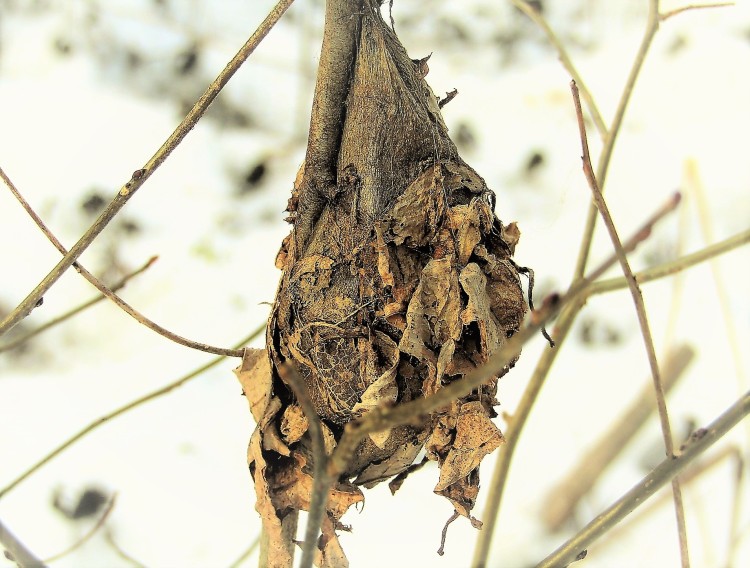
I don’t know how many times I walked past this strange looking object before recognizing it as a living creature. It resides near the trail, attached to a small Spicebush at a height of two feet, looking most intentionally like a clump of dead leaves. It’s actually the winter survival capsule for one of North America’s largest giant silkmoths, the Cecropia, Hyalophora cecropia. And like many insects, it’s in a state of “diapause”, the pupa slumbering secure in its silken bag till spring.
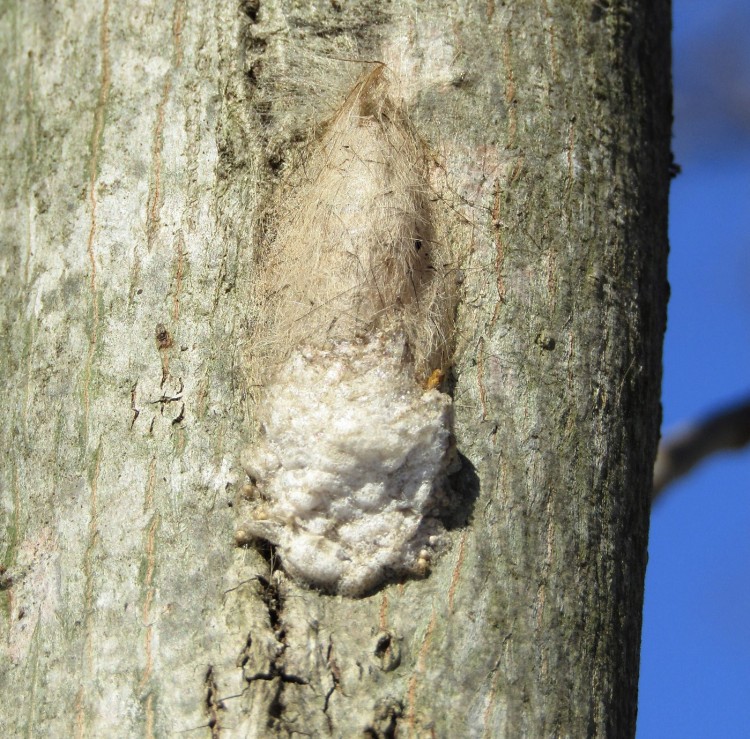
Winter is a great time to notice things, free from distracting leafy clutter. The above pic shows another cocoon on a tree that I must have passed countless times before seeing it. Having no background in entomology, this one was baffling. After an hour of various image searches, I lucked out with “hairy foamy cocoon on tree”, and was rewarded with a similar image titled White-marked Tussock Moth (Orgyia leucostigma). This is the female moth’s cocoon, and since she’s wingless, her foamy white egg mass is right on her cocooon.
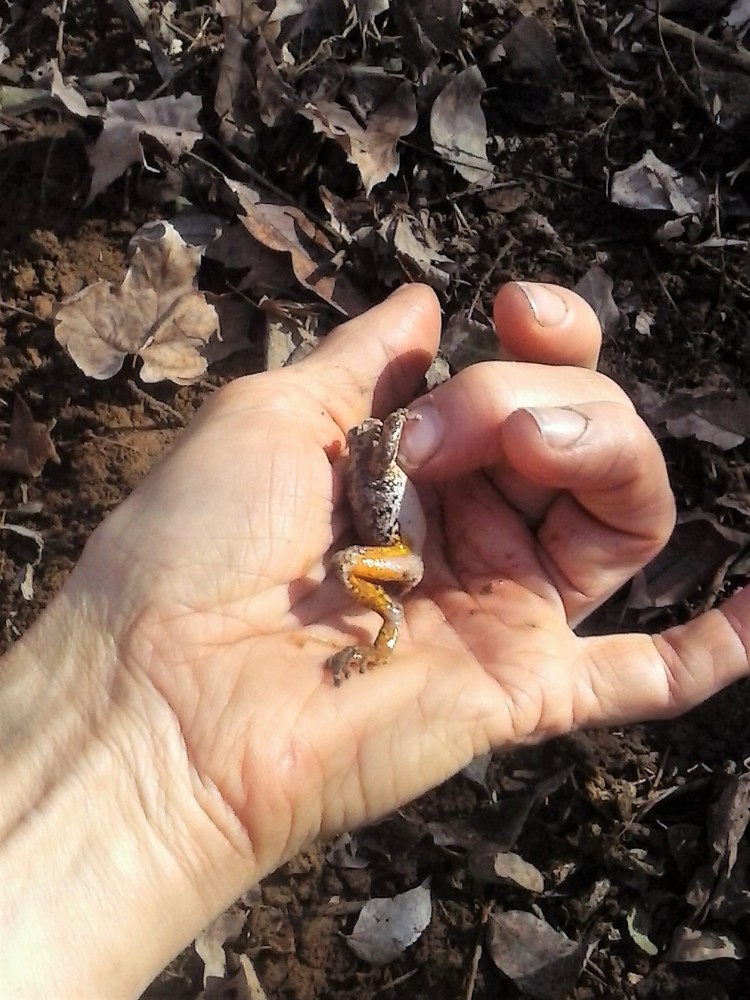
When times are tough, the tough are more likely to hunker down. To survive predictable adverse seasons like winter, most animals and plants have evolved strategies to use the bare minimum of energy. Dormancy, diapause, hibernation, and just sleeping a lot help conserve stored energy reserves as long as possible. Waking from hibernation unexpectedly can be fatal. In fact, bats infected with White-nose fungal syndrome during hibernation usually starve before succumbing to the disease. The infection rouses them, and precious fat reserves are sapped by the abnormal winter activity.
Animals that stay active in winter need strategies for conserving energy too, since food may be scarce and it’s harder to stay warm. After last week’s snowfall I spotted these Red fox tracks navigating the length of a fallen trunk – a very foxy thing to do.
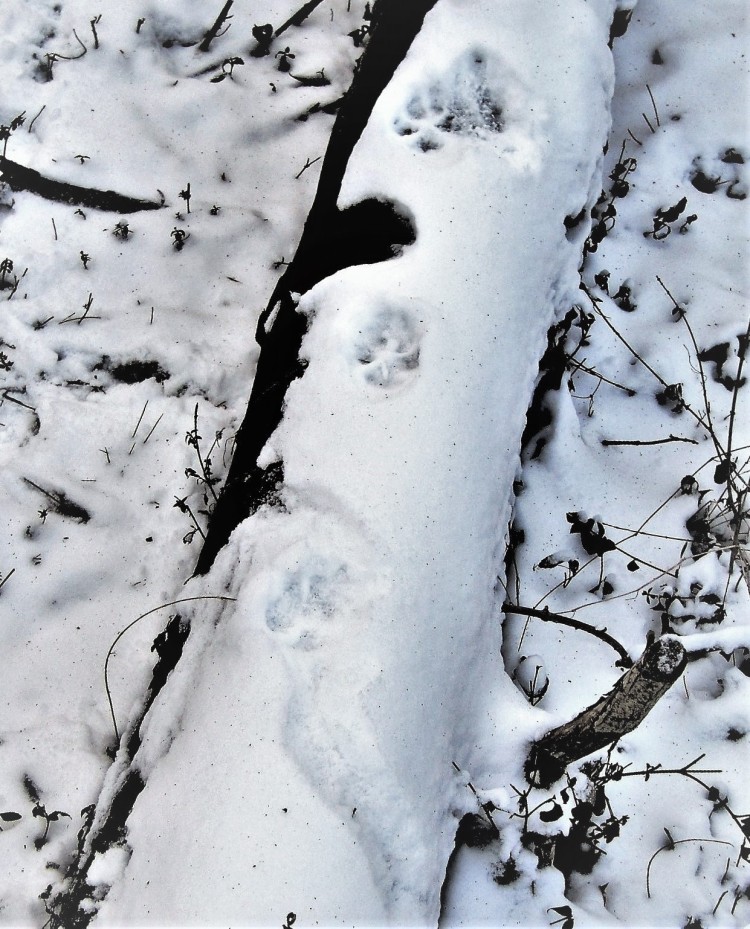
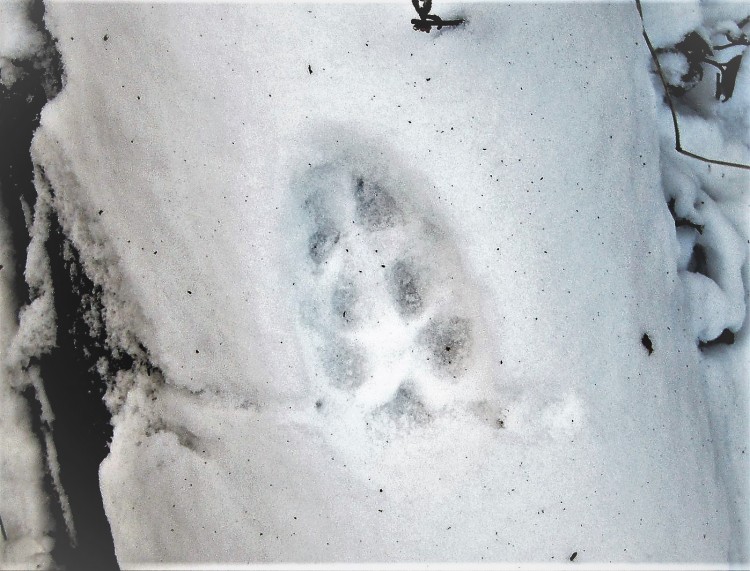
A closer look shows just how neatly foxes step, placing the rear foot right into the front foot track. This is called “direct register walking”; it allows wild canids, felines and other animals to move more efficiently and quietly. In rough terrain or deep snow the energy savings would be significant.
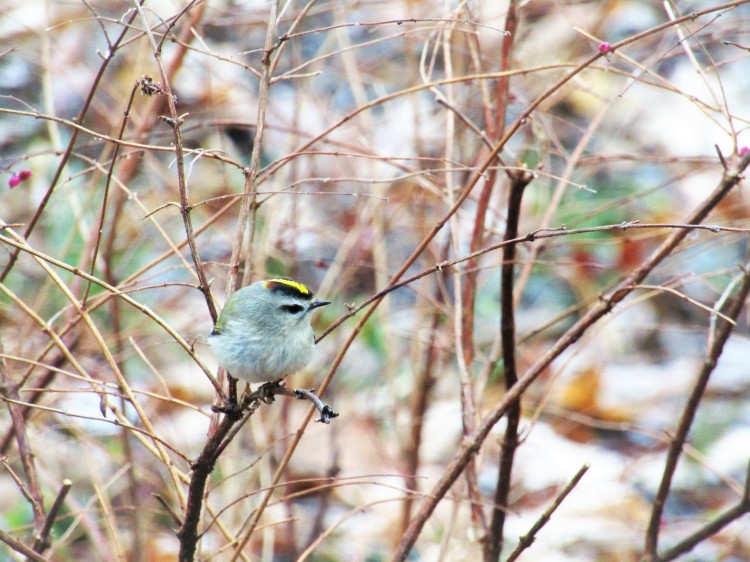
Birds seem to take the opposite tack; being highly mobile they may move around even more to avoid adverse conditions. Small birds like the Golden crowned kinglet in the pic above visit our forest only in winter, the equivalent of a Florida holiday for this tiny northern species. It’s described as an “active” forager which is an understatement – getting a pic of one perching momentarily was a lucky accident. The ten other pics show only a blur of a bird fluttering in midair, dangling from the tips of branches, etc, etc. This continual foraging, mostly in evergreens, is the kinglet’s way of surviving the harsh climate it calls home.
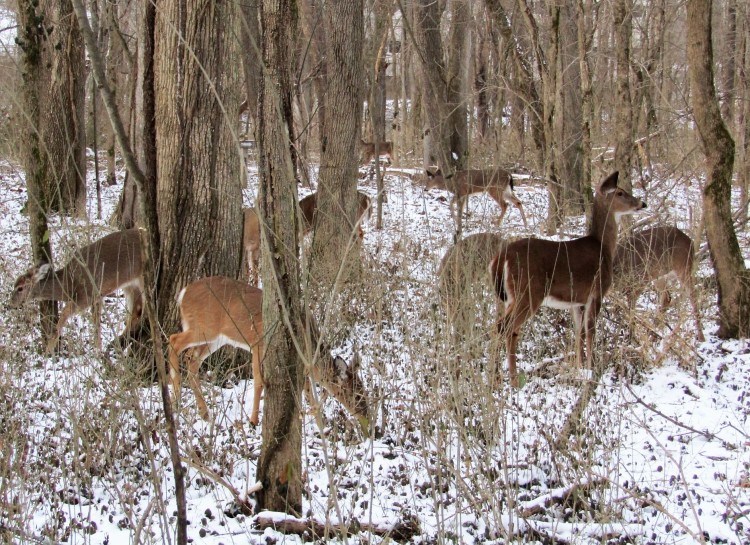
And then there are the deer, the most visible large animals in this forest. In late winter they herd up into larger groups that include both bucks and does, as well as many yearlings. A light cover of snow makes their foraging activity easier to observe – particularly in winter, the strategy is “put your head down and eat”. Due to the relatively low nutritional value of winter forage, it takes many more hours of eating to get your calories.
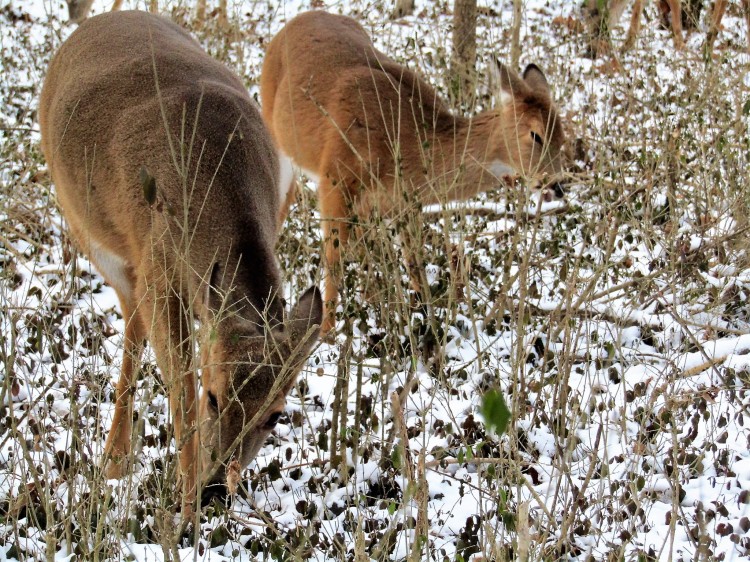
This doe and her young one were browsing Privet and the relatively nutritious evergreen leaves of Wintercreeper. The invasive groundcover is gaining ground in this forest, and appears to be a primary winter food. So as long as snow doesn’t cover it, no one goes hungry.
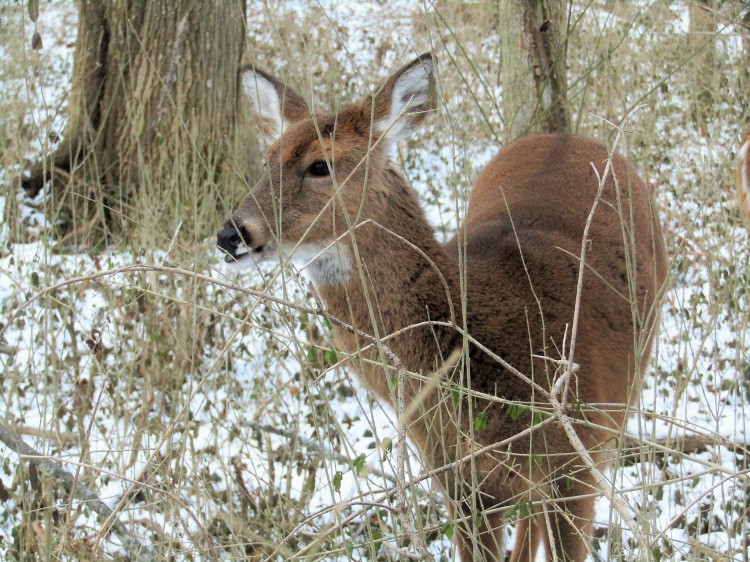
It always amazes me how such large animals can wrest enough nutrition from winter twigs and leaves. But they do, and do it well, judging by burgeoning deer populations. Their highly efficient four chambered stomach is the secret; in one of the chambers microorganisms ferment tough cellulose, rendering it digestible.
We’re in for a very cold spell over the next week; a nice chance to get out and observe some winter behaviors. It’s an opportunity as well to check the fitness of your own winter adaptations – which in my case consist of Kamik hunting boots with felt liners, three pairs of gloves including military surplus leather outer mittens, and my signature fake fur aviator hat.
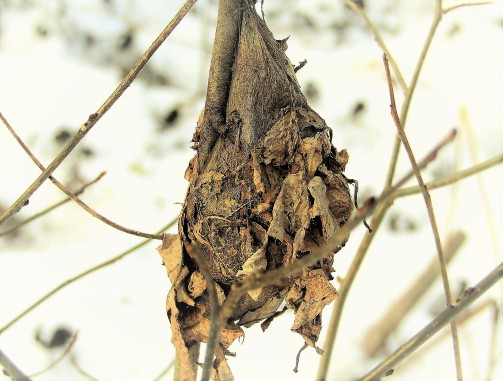
Ann Rosa
Fascinating!! Makes want to look around even more when hiking.
LikeLiked by 1 person
oneforestfragment
Thanks Ann! I forget to look around sometimes, but needing to come up with something to write makes me do it
LikeLike
Nancy Bickel
Thanks for the golden crowned kinglet picture. Beautiful.
LikeLiked by 1 person
oneforestfragment
Thanks Nancy! These and the Ruby-crowned are real winter jewels with their tiny bright crests.
LikeLike
shoreacres
In two days, I’ve identified an ambush bug from a Nebraska prairie blog, and now I suspect I may have found a tussock moth cocoon, thanks to yours. I found the odd thing on a plant stalk at a nearby refuge: it looked like a cocoon, but it was covered with a white, foamy mass that looked like eggs on one side. Now that I know we have Orgyia leucostigma here in Texas, and the photos I’ve found look so similar, I should be able to get a postive ID.
I enjoyed all of the photos and descriptions. I say I wouldn’t like to live in snow country, and that’s probably true, but on the other hand, I grew up there, and loved it. It’s fascinating to learn more about some of the survival strategies employed by species who don’t have a thermostat and Uber Eats.
LikeLiked by 1 person
oneforestfragment
Glad to help! Back in the day, it was so hard to ID anything, you had to have a library of field guides – I still do but don’t use them much. We don’t really live in snow country, it was always spotty and there’s even less now, so when it comes it’s fun to get out and look for tracks.
LikeLiked by 1 person
Kim Fritschi
Thank you so much! This month’s article was particularly beautiful. I shared it on my Facebook page. Blessings of the day!
Kim
LikeLiked by 1 person
oneforestfragment
Thank-you so much!
LikeLike
Janet Mayer
Thanks for sharing this! We haven’t been able to get outside much since moving in cause we’ve been in “renovation mode” with the <a href=”https://www.redboxplus.com/omaha/dumpster-rental-louisville-ne/”>dumpster rental</a> and everything. We’re finally finishing up, and I’ve been so excited to get back outside and appreciate the natural beauty of our new home. Thank you for sharing!
LikeLike
Janet Mayer
Thanks for sharing this! We haven’t been able to get outside much since moving in cause we’ve been in “renovation mode” with the dumpster rental and everything. We’re finally finishing up, and I’ve been so excited to get back outside and seen the birds in our new home state. Thank you for sharing!
LikeLike